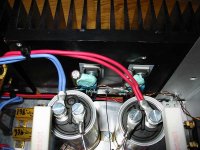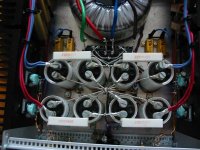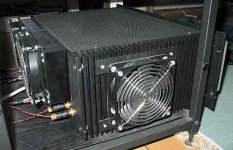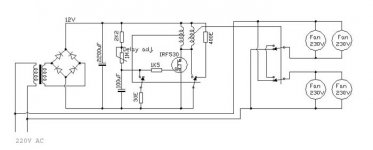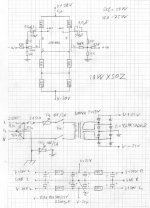Some technical info:
-The circuit used is Henrik's XSOZ circuit, with 6,8R power resistor (Arcol HS50) instead of the 7,5ohm.
-Rails are at +/- 20VDC
-Bias is slightly greater than 4A per channel.
-MOSFETs are IRFP140A from Fairchild
-Dual discrete bridges made of 8 ISL9R3060G2 (30A, 600V Stealth Diode to247, Fairchild)
-Psu caps are Evox Rifa PEH200 22000uF/25V.
-220uF caps are Elna RJH bypassed with 0,15uF Evox Rifa PHE426.
-Light AC filtering with Evox Rifa PZB 300 in delta-arrangement.
-Circuit ground is connected to the chassis/AC GND via a ntc thermistor. I have also used a ntc to supress the turn on surge.
-Chassis temp is about 70'C. The heatsink carrying the MOSFETs is 77'C. The one carrying the power resistors is 112'C.
-The circuit used is Henrik's XSOZ circuit, with 6,8R power resistor (Arcol HS50) instead of the 7,5ohm.
-Rails are at +/- 20VDC
-Bias is slightly greater than 4A per channel.
-MOSFETs are IRFP140A from Fairchild
-Dual discrete bridges made of 8 ISL9R3060G2 (30A, 600V Stealth Diode to247, Fairchild)
-Psu caps are Evox Rifa PEH200 22000uF/25V.
-220uF caps are Elna RJH bypassed with 0,15uF Evox Rifa PHE426.
-Light AC filtering with Evox Rifa PZB 300 in delta-arrangement.
-Circuit ground is connected to the chassis/AC GND via a ntc thermistor. I have also used a ntc to supress the turn on surge.
-Chassis temp is about 70'C. The heatsink carrying the MOSFETs is 77'C. The one carrying the power resistors is 112'C.
Attachments
Hi Mad_K, sorry for calling you Kad_K.
My XSOZ runs at the same railvoltage, but my regulators eats about 6v, so I have a little more heat to dissipate than you.
Yes I know some people don´t like to use fans, but in my oppinion it is not a big deal, I have had an SOZ and XSOZ running with fans for more tan 3 years now, it dosen´t bother me at all. But you need to use some silent fans. I ended up with 4 x 220V slimline sleevebearing fans, 2 X 2 in parallel to reduce the airflow and the noice, and this is verry effectieve. You have to start the fans non paralleled in order to start the up, and then couple them in paralleled mode.
I can touch my heatsinks, i guess they are 50*C for the mosfetsinks and 60*C for the resistorsinks.
My fans measures 120 x 120 x 25 mm.
I also build my first XSOZ with the rectifires mounted at the same plate as the PSU-caps, but now i have mounted them at the mosfetsinks.
I have had an SOZ with only 15V rails, that were not enough for my 15 Ohm 90db speakers, i missed some headroom at the higer volume.
You have done a vonderful job, real nice, and i sincerely hope you will find a cure for this hot darling, one way or the other.
I have attached a pic of my fans.
Regards Henrik
Mad_K said:The penalty for this is a firebreathing hot amp that runs all of the components on its limits, I doubt that it will last very long in its present condition, but tweaking/tuning will take care of that (I will have to scale it down a little power-wise).
My XSOZ runs at the same railvoltage, but my regulators eats about 6v, so I have a little more heat to dissipate than you.
Yes I know some people don´t like to use fans, but in my oppinion it is not a big deal, I have had an SOZ and XSOZ running with fans for more tan 3 years now, it dosen´t bother me at all. But you need to use some silent fans. I ended up with 4 x 220V slimline sleevebearing fans, 2 X 2 in parallel to reduce the airflow and the noice, and this is verry effectieve. You have to start the fans non paralleled in order to start the up, and then couple them in paralleled mode.
I can touch my heatsinks, i guess they are 50*C for the mosfetsinks and 60*C for the resistorsinks.
My fans measures 120 x 120 x 25 mm.
I also build my first XSOZ with the rectifires mounted at the same plate as the PSU-caps, but now i have mounted them at the mosfetsinks.
I have had an SOZ with only 15V rails, that were not enough for my 15 Ohm 90db speakers, i missed some headroom at the higer volume.
You have done a vonderful job, real nice, and i sincerely hope you will find a cure for this hot darling, one way or the other.
I have attached a pic of my fans.
Regards Henrik
Attachments
A more sober statement
After nearly 9 hours of listening to the XSOZ last night, here's my highly subjective opinion of what this thing sounds like:
The sound of the XSOZ is just amazing. First of all, it's bass control is a lot better than that of the SOZ. The crisp, sharp treble of the SOZ seems a bit damped, but the depth is still there. Still, I can't help but miss the mid-range sound of the GC. The details are certainly there, but they seem to fall a bit down in the back.
In total, the depth and width of the total soundstage is the best thing I've heard. The resolution is amazing. Neil Young sat in front of us playing Heart of Gold, Dire Straits played the guitar on the MTV like never before, and Pink Floyd never sounded that good. The division bell was everywhere. The wall was coming down. The experience is better than anything else I've heard.
This is high fidelity, and I'd sure like it to come to my livingroom as well.
After nearly 9 hours of listening to the XSOZ last night, here's my highly subjective opinion of what this thing sounds like:
The sound of the XSOZ is just amazing. First of all, it's bass control is a lot better than that of the SOZ. The crisp, sharp treble of the SOZ seems a bit damped, but the depth is still there. Still, I can't help but miss the mid-range sound of the GC. The details are certainly there, but they seem to fall a bit down in the back.
In total, the depth and width of the total soundstage is the best thing I've heard. The resolution is amazing. Neil Young sat in front of us playing Heart of Gold, Dire Straits played the guitar on the MTV like never before, and Pink Floyd never sounded that good. The division bell was everywhere. The wall was coming down. The experience is better than anything else I've heard.
This is high fidelity, and I'd sure like it to come to my livingroom as well.
Thanks for the nice words, and I really appreciate your suggestions Henrik 😉
I am sitting here contemplating my options on how to get the temps down.. I thought I was going to get away without using fans, but it seems that was just a nice dream..
-How do you power your fans? separate supply or regulated from the main rails?
I am sitting here contemplating my options on how to get the temps down.. I thought I was going to get away without using fans, but it seems that was just a nice dream..
-How do you power your fans? separate supply or regulated from the main rails?
Hi again.
My fans are running at 220V AC.
Once I tried 12VDC ballbearing fans, but they made too much nocie, and i ran the from a separate supply. Sleevebearing seems to make less nocie than ballbearing.
And don´t use fans at 120 x 120 x 50mm if you can avoid that.
As I see your heatsinks, they have pretty deep fins, which makes them more effective than mine.
My fans are running at 220V AC.
Once I tried 12VDC ballbearing fans, but they made too much nocie, and i ran the from a separate supply. Sleevebearing seems to make less nocie than ballbearing.
And don´t use fans at 120 x 120 x 50mm if you can avoid that.
As I see your heatsinks, they have pretty deep fins, which makes them more effective than mine.
Attachments
the bypass cap is a neat idea... hadn't thought of that.
thanks for posting the closeups of the FETS... i was really interested
to see if what i had done looked anything like what someone
who knows what they're doing did! 🙂
i take it the blue material is a dampening device? to keep the
capacitors from just hanging there? What is that stuff? I think i'd
like to try that on my amp.
i like the symmetry that your amp has on each channel...
PassLabs makes a point of that in their X amps.
it's really cool to see some more X-SOZ's being made. More of you
should try building this wonderful amp, you won't be let down!!
(as long as your speakers are up to it!)
((FirstWatt dare not make an X-SOZ... it may eat into the sales of the real stuff!!)) ha ha 😉
thanks for posting the closeups of the FETS... i was really interested
to see if what i had done looked anything like what someone
who knows what they're doing did! 🙂
i take it the blue material is a dampening device? to keep the
capacitors from just hanging there? What is that stuff? I think i'd
like to try that on my amp.
i like the symmetry that your amp has on each channel...
PassLabs makes a point of that in their X amps.
it's really cool to see some more X-SOZ's being made. More of you
should try building this wonderful amp, you won't be let down!!
(as long as your speakers are up to it!)
((FirstWatt dare not make an X-SOZ... it may eat into the sales of the real stuff!!)) ha ha 😉
In post #24 i wrote:
"I ended up with 4 x 220V slimline sleevebearing fans, 2 X 2 in parallel to reduce the airflow and the noice, and this is verry effectieve. You have to start the fans non paralleled in order to start the up, and then couple them in paralleled mode"
It shoud have ben:
I ended up with 4 x 220V slimline sleevebearing fans, 2 X 2 in series to reduce the airflow and the noice, and this is verry effectieve. You have to start all the fans in parallel in order to start them up, and then couple them in 2 x 2 serial mode.
Like in the scematic in post #27
Sorry for the confusion.
"I ended up with 4 x 220V slimline sleevebearing fans, 2 X 2 in parallel to reduce the airflow and the noice, and this is verry effectieve. You have to start the fans non paralleled in order to start the up, and then couple them in paralleled mode"
It shoud have ben:
I ended up with 4 x 220V slimline sleevebearing fans, 2 X 2 in series to reduce the airflow and the noice, and this is verry effectieve. You have to start all the fans in parallel in order to start them up, and then couple them in 2 x 2 serial mode.
Like in the scematic in post #27
Sorry for the confusion.
-You're welcome moe29!
The "blue stuff" is called Blue-Tac and is primarily used to damp vibrations, but it also helps in keeping them in place. It is made for hanging posters on walls, but also makes a very good dampening material.
I understood what you meant Henrik 😉 Thanks for the info. I'm curious; what's the reason for your pseudo ground psu?
I think I will just bite the bullet and order a new trafo; they're not that expensive (as opposed to the amp blowing up my $3000 speakers). This will degrade the power rating to about 5W per channel. I have lots of heatsinks and another trafo just like the one I have currently installed that I can use later for making even more powerful XSOZ monoblocks (~15W).
The "blue stuff" is called Blue-Tac and is primarily used to damp vibrations, but it also helps in keeping them in place. It is made for hanging posters on walls, but also makes a very good dampening material.
I understood what you meant Henrik 😉 Thanks for the info. I'm curious; what's the reason for your pseudo ground psu?
I think I will just bite the bullet and order a new trafo; they're not that expensive (as opposed to the amp blowing up my $3000 speakers). This will degrade the power rating to about 5W per channel. I have lots of heatsinks and another trafo just like the one I have currently installed that I can use later for making even more powerful XSOZ monoblocks (~15W).
Mad_K
First reason was that I had those 33V transformers without split secondaries on hand from an other project.
The regulated supply becomes more simpel, and it works pretty good.
The caps in the supply are working directly from + to -, where the the current draw is high. In split supplies the caps are pairs in series, which may or may not degrade the sound, but i believe that one single cap works better than two in series. Since the current flow through the ground is < 1 mA under normal conditions, it may be overkill to use those big caps to cover that little current, specially when the price paid is two in series instead of just one cap to take care of the high current draw from + to -.
I haven´t made any tests to compare those PSU´s side by side, so I don´t really know what sounds the best, so I am not an expert, i am a believer.
But I know that my XSOZ has a verry nice sound compared to others.
First reason was that I had those 33V transformers without split secondaries on hand from an other project.
The regulated supply becomes more simpel, and it works pretty good.
The caps in the supply are working directly from + to -, where the the current draw is high. In split supplies the caps are pairs in series, which may or may not degrade the sound, but i believe that one single cap works better than two in series. Since the current flow through the ground is < 1 mA under normal conditions, it may be overkill to use those big caps to cover that little current, specially when the price paid is two in series instead of just one cap to take care of the high current draw from + to -.
I haven´t made any tests to compare those PSU´s side by side, so I don´t really know what sounds the best, so I am not an expert, i am a believer.
But I know that my XSOZ has a verry nice sound compared to others.
You luckey guy.I have lots of heatsinks and another trafo just like the one I have currently installed that I can use later for making even more powerful XSOZ monoblocks (~15W).
The hottest amp on the block...
Well, after having spent a few hours in the tinking bin, I have decided to let the amp run this hot
I have calcuated that the junctions of the MOSFETs and the maximum hotspot temp in the resistors are both about 50'C below their maximum operating temperature.
In an effort to try to lower the surrounding chassis-temp I have decreased the thermal coupling from the heatsinks to the rest of the frame. I have also done the same with the 1 ohm power resistors that where heating up my bottom plate.
As my creations rarely have a lifespan more than a few years and the components are often excanged during this period (I already know I will be trying different MOSFETs), I figure that my speakers are relatively safe 😉
So, after a few lousy days listening to my GC, it's back to this fantastic little amp...
Well, after having spent a few hours in the tinking bin, I have decided to let the amp run this hot

I have calcuated that the junctions of the MOSFETs and the maximum hotspot temp in the resistors are both about 50'C below their maximum operating temperature.
In an effort to try to lower the surrounding chassis-temp I have decreased the thermal coupling from the heatsinks to the rest of the frame. I have also done the same with the 1 ohm power resistors that where heating up my bottom plate.
As my creations rarely have a lifespan more than a few years and the components are often excanged during this period (I already know I will be trying different MOSFETs), I figure that my speakers are relatively safe 😉
So, after a few lousy days listening to my GC, it's back to this fantastic little amp...
Fearless DIY
...not a bad idea. Power resistors can run a lot closer to their max
operating temps pretty safely. And if a FET goes.. there aren't a
whole lot of them to replace! (as long as it doesn't take
(as long as it doesn't take
out your speaker)
...not a bad idea. Power resistors can run a lot closer to their max
operating temps pretty safely. And if a FET goes.. there aren't a
whole lot of them to replace!
 (as long as it doesn't take
(as long as it doesn't takeout your speaker)
Excactly moe29; Fearless DIY indeed 😉
That may well be Variac... Maybe I'm not that fearless after all? 😉
But, anyone trying to touch it in the wrong place might feel some fear 😀 hehe 😀
The sound of this amp has been described by some of my close friends earlier in this thread, I think I will add as a personal note that listening to this amp is a bit like hypnosis. This little fellow completely seduces me with its remarkable sonic power. As moe29 pointed out, it has the blackest of black, yet the crispest of crisp. To quote a famous norwegian audio designer "Music is all about dynamics!" Some audiophiles like to call it "musical", but while this is true, I feel that this may give an impression that the sound is laid back and nice and never bites. I feel that the amp presents the music in all it's colours, yet in a subtle enough way that you're not thinking about it, you just get so involved with the music that you forget anything else. It kind of sneaks in a back door to the musical register in your brain. For me this is a perfect amp. While my BGC is very nice, especially the midrange is very involving, I feel that the XSOZ does it all much better in a more mature, discrete (no pun intended) way. Thorsten once said that his goal was "details without fatigue", and this amp gives you excactly that. I can't wait to get home from work and warm my fingers (it's like -15'C here in Trondheim), not to mention varm my ears and all the other senses and feelings my system now is capable of resolving.
/Mad_K -one happy diy'er
That may well be Variac... Maybe I'm not that fearless after all? 😉
But, anyone trying to touch it in the wrong place might feel some fear 😀 hehe 😀
The sound of this amp has been described by some of my close friends earlier in this thread, I think I will add as a personal note that listening to this amp is a bit like hypnosis. This little fellow completely seduces me with its remarkable sonic power. As moe29 pointed out, it has the blackest of black, yet the crispest of crisp. To quote a famous norwegian audio designer "Music is all about dynamics!" Some audiophiles like to call it "musical", but while this is true, I feel that this may give an impression that the sound is laid back and nice and never bites. I feel that the amp presents the music in all it's colours, yet in a subtle enough way that you're not thinking about it, you just get so involved with the music that you forget anything else. It kind of sneaks in a back door to the musical register in your brain. For me this is a perfect amp. While my BGC is very nice, especially the midrange is very involving, I feel that the XSOZ does it all much better in a more mature, discrete (no pun intended) way. Thorsten once said that his goal was "details without fatigue", and this amp gives you excactly that. I can't wait to get home from work and warm my fingers (it's like -15'C here in Trondheim), not to mention varm my ears and all the other senses and feelings my system now is capable of resolving.
/Mad_K -one happy diy'er
Considering that I now have all the components for my Xsoz, I'm pretty excited to get your report. My amps size? 10watts/ch Bwahahahaahha! I think I have a lot better cooling though-we'll see.





Cooling, smooling.... It's the size that matters 😉
Seriously, you'll get even more excited when you get it up and running. It's a really nice amp...
Seriously, you'll get even more excited when you get it up and running. It's a really nice amp...
Wiki....whos Wiki ???
OK....now you dont have much of an excuse anymore Mad_K....
Please make a short description of the hurdeles of the constructions, a list of components (including trafos and so on)....and a few subjective words of praise 😉
Ohh, and a schematic as well....gotta get that wiki thing going.
travelling_mac@yahoo.com
Cheers
Magura
OK....now you dont have much of an excuse anymore Mad_K....
Please make a short description of the hurdeles of the constructions, a list of components (including trafos and so on)....and a few subjective words of praise 😉
Ohh, and a schematic as well....gotta get that wiki thing going.
travelling_mac@yahoo.com
Cheers
Magura
Here you go Magura!
The rest of the info you are asking are already in this thread..
No special hurdles in construction (Except a broken tap bit). The amp was made during a usual working week plus over the weekend. I had almost all of the parts in my junk-box already, so the amp was pretty much designed around that. I have no special tools. The only power tools I have is a Dremel and a power drill. Also I have no place to work on it so the living room/hallway was the constructionsite.
Heatsinks are Austerlitz KS160-100.
Please be advised that I do strongly recommend at least a 800VA trafo, and double the amount of heatsinking.
Please ask specific questions if you need/want more info 😉
The rest of the info you are asking are already in this thread..
No special hurdles in construction (Except a broken tap bit). The amp was made during a usual working week plus over the weekend. I had almost all of the parts in my junk-box already, so the amp was pretty much designed around that. I have no special tools. The only power tools I have is a Dremel and a power drill. Also I have no place to work on it so the living room/hallway was the constructionsite.
Heatsinks are Austerlitz KS160-100.
Please be advised that I do strongly recommend at least a 800VA trafo, and double the amount of heatsinking.
Please ask specific questions if you need/want more info 😉
Attachments
- Status
- Not open for further replies.
- Home
- Amplifiers
- Pass Labs
- 10w Xsoz
